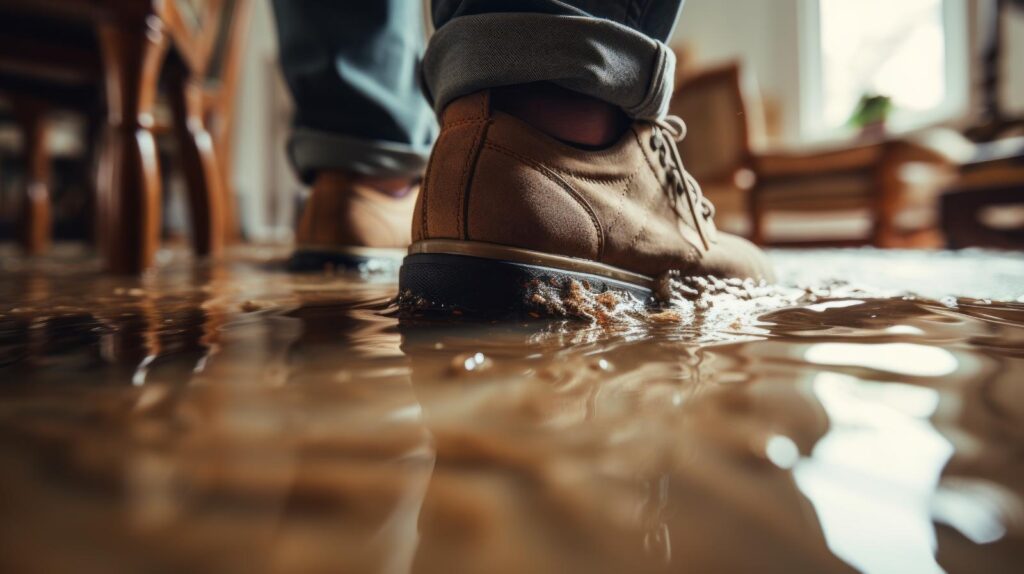
Contents
When faced with water damage, knowing how to respond effectively is essential. You must first assess the area to understand the extent of the damage and identify the source. With the right equipment and techniques, you can minimize the impact considerably. However, the process doesn’t end with water extraction; proper drying and cleaning are equally important. Understanding each step can make a notable difference in preventing long-term issues. What comes next might surprise you.
Key Takeaways
- Use a wet/dry vacuum to efficiently remove standing water from floors and carpets.
- Employ squeegees to direct water toward a drain or exit to facilitate removal.
- Utilize fans to enhance air circulation and speed up the drying process.
- Clean surfaces with a bleach solution after removing debris to sanitize effectively.
- Monitor moisture levels with a moisture meter to ensure complete drying and prevent mold.
Assessing the Extent of Water Damage
When dealing with water damage, the first step is to accurately assess its extent. Start by inspecting the affected areas thoroughly.
Look for visible signs such as discoloration, warping, or mold, which indicate the presence of moisture. Don’t forget to check behind walls and beneath flooring, as hidden damage can lead to further complications.
Next, determine the source of the water. Is it from a burst pipe, flooding, or a leaking roof? Identifying the cause is essential for effective cleanup and prevention of future issues.
Evaluate the type of water involved: clean, gray, or black. This classification will guide your cleanup strategy and safety measures.
Finally, document your findings with photos and notes, which can be invaluable for insurance claims or professional assessments.
Gathering Necessary Equipment and Supplies
To effectively tackle water damage, you’ll need a range of essential equipment and supplies at your disposal. Gathering the right tools guarantees a smoother recovery process. Here’s a quick reference table to help you organize what you’ll need:
| Equipment/Supply | Purpose | Example Models/Brands |
|---|---|---|
| Wet/Dry Vacuum | Removes standing water | Shop-Vac, Craftsman |
| Fans | Promotes air circulation | Lasko, Vornado |
| Dehumidifier | Reduces moisture levels | Frigidaire, hOmeLabs |
| Mop and Buckets | For manual cleanup | Rubbermaid, O-Cedar |
| Protective Gear | Guarantees safety during cleanup | Rubber gloves, masks |
Initial Water Removal Techniques
As soon as you’ve gathered your equipment and supplies, it’s crucial to begin initial water removal techniques to minimize damage.
Swift action will help safeguard your space and belongings. Here are three effective methods to kickstart the process:
- Squeegees: Use a squeegee to push water toward a drain or out of a door. This tool is efficient for flat surfaces.
- Wet/Dry Vacuum: A wet/dry vacuum is ideal for sucking up standing water. Make sure to follow the manufacturer’s instructions to avoid damage.
- Mops and Towels: For smaller amounts of water, absorbent mops and towels can help soak up moisture quickly.
Implementing these techniques promptly can greatly reduce the risk of mold growth and structural damage.
Drying Out the Affected Area
Once you’ve removed the excess water, it’s essential to assess moisture levels in the affected area to determine the extent of drying needed.
Utilizing fans effectively can greatly speed up the evaporation process, while understanding proper dehumidifier placement will enhance efficiency.
Assess Moisture Levels
Many homeowners underestimate the importance of accurately appraising moisture levels after a water incident.
Evaluating moisture is essential to prevent mold growth and structural damage. You’ll need to use a moisture meter for precise readings and guarantee you check various surfaces within the affected area.
- Inspect walls, floors, and ceilings.
- Pay attention to hidden areas like behind appliances or under carpets.
- Monitor humidity levels in the room.
Utilize Fans Effectively
After evaluating moisture levels, the next step is to utilize fans effectively to dry out the affected area.
Position high-powered fans to maximize airflow; place them in strategic locations, pointing toward the wet surfaces. This creates a circulation pattern that accelerates evaporation, greatly reducing drying time.
Make sure windows and doors are open to enhance cross-ventilation, which helps disperse moisture-laden air. If possible, use multiple fans to cover larger areas, adjusting their angles as needed to target specific damp spots.
Monitor the drying progress regularly; keep an eye out for lingering moisture or mold growth, as timely action is essential.
Dehumidifier Placement Tips
To effectively dry out the affected area, placing dehumidifiers in strategic locations is vital. Proper placement accelerates moisture removal and guarantees a more efficient drying process.
Here are some key tips for dehumidifier placement:
- Center the unit: Position your dehumidifier in the middle of the room to maximize airflow and capture humidity from all directions.
- Elevate if possible: Placing the unit on a sturdy table or platform can enhance air circulation and allow it to work more effectively.
- Avoid obstacles: Keep the dehumidifier away from walls and furniture to prevent airflow blockage.
Cleaning and Sanitizing Surfaces
While standing water can lead to significant damage and health risks, effectively cleaning and sanitizing surfaces is vital in preventing mold growth and guaranteeing a safe environment.
Start by removing any debris and excess moisture from the affected area. Use a mixture of warm water and a mild detergent to scrub hard surfaces, making sure you reach corners and crevices where contaminants might hide.
After cleaning, it’s essential to sanitize. A solution of one cup of bleach per gallon of water works well for non-porous surfaces. Apply it generously and let it sit for at least ten minutes before rinsing with clean water.
For porous materials, consider using a commercial disinfectant specifically designed for those surfaces.
Always wear gloves and maintain proper ventilation while working.
Preventing Mold Growth
To effectively prevent mold growth, you need to implement quick drying methods immediately after a water incident.
Regular inspections of vulnerable areas also play a critical role in catching potential mold before it becomes a problem.
Quick Drying Methods
When water damage occurs, quick drying methods are essential in preventing mold growth, as mold can begin to develop within 24 to 48 hours in damp environments.
To effectively dry out your space, consider these techniques:
- Ventilation: Open windows and doors to promote airflow. Use fans to circulate air efficiently.
- Dehumidifiers: Invest in a dehumidifier to extract moisture from the air, lowering humidity levels.
- Absorbent Materials: Utilize towels or mops to soak up excess water, and consider using moisture-absorbing products like silica gel.
Implementing these methods promptly can meaningfully reduce the likelihood of mold growth, ensuring a safer and healthier environment for you and your loved ones.
Taking action quickly is key!
Regular Inspections Importance
After implementing quick drying methods, maintaining a consistent inspection routine is essential for preventing mold growth.
Regular checks help you identify any lingering moisture or early signs of mold, allowing for prompt action.
Focus on areas like basements, bathrooms, and around appliances, as these spots are often prone to dampness.
Disposing of Damaged Materials
Disposing of damaged materials is essential for preventing further contamination and ensuring a safe environment.
When you face water damage, the first step is to identify and remove any items that can’t be salvaged. This helps minimize health risks and promotes a quicker recovery process.
Here are some guidelines to follow when disposing of damaged materials:
- Assess Items: Evaluate which items, like carpets, drywall, or furniture, are beyond repair.
- Follow Local Regulations: Check your local waste management guidelines for proper disposal methods.
- Consider Donation: If items are merely wet but salvageable, consider donating them to local charities after proper drying and sanitizing.
Tips for Future Water Damage Prevention
To effectively prevent future water damage, it’s crucial to adopt proactive measures that safeguard your home. Start by inspecting your roof and gutters regularly; clean debris to guarantee proper drainage. Additionally, check for leaks in plumbing, as small drips can escalate into significant issues.
Consider investing in a sump pump if you live in a flood-prone area, and use water-resistant materials in vulnerable spaces like basements.
| Action | Frequency |
|---|---|
| Inspect gutters | Biannually |
| Check plumbing | Quarterly |
| Assess sump pump | Monthly |
Implementing these strategies not only protects your home but also fosters a sense of community responsibility. By sharing your knowledge with neighbors, you contribute to a safer environment for everyone. Stay vigilant about water damage prevention, and your home will remain a sanctuary for years to come.
Review
In the aftermath of a water event, taking swift action can turn an intimidating situation into a manageable task. By evaluating damage, removing water, and ensuring thorough drying and sanitization, you can restore your space to its former glory. Remember, preventing mold growth is key to maintaining a healthy environment. With proper techniques and a proactive mindset, you’re not just cleaning; you’re rejuvenating your home, transforming challenges into opportunities for improvement and resilience.
Recent Posts
Choosing Genuine Water Extraction Tools for Restoration
When tackling water damage restoration, choosing genuine water extraction tools is essential for effective results.
Selecting the Right Tools for Water Extraction
Did you know that improper water extraction can lead to up to 40% more damage
3 Tips for Selecting Water Extraction Tools
Many people overlook the impact of water type on extraction tool selection, yet it’s vital
